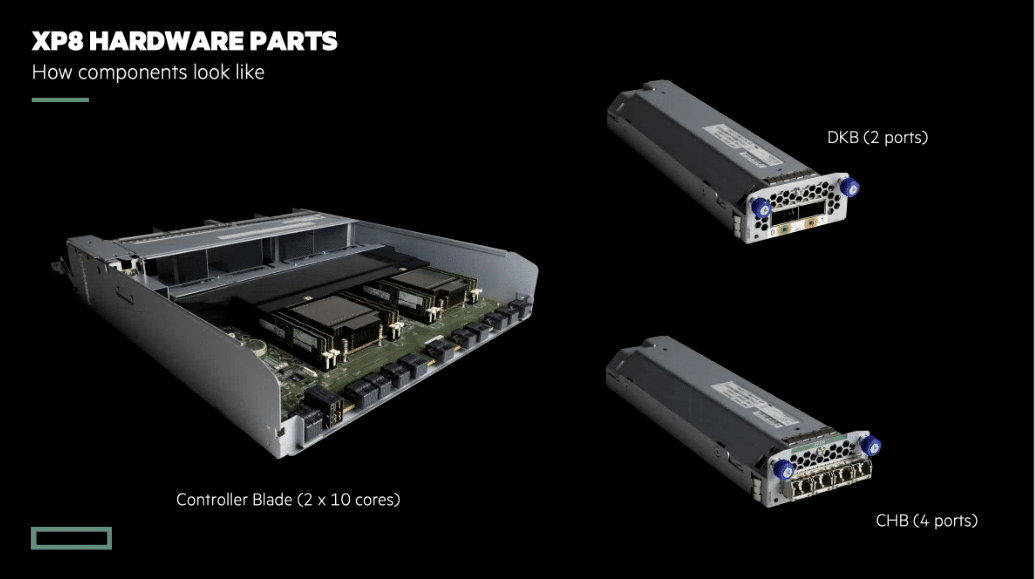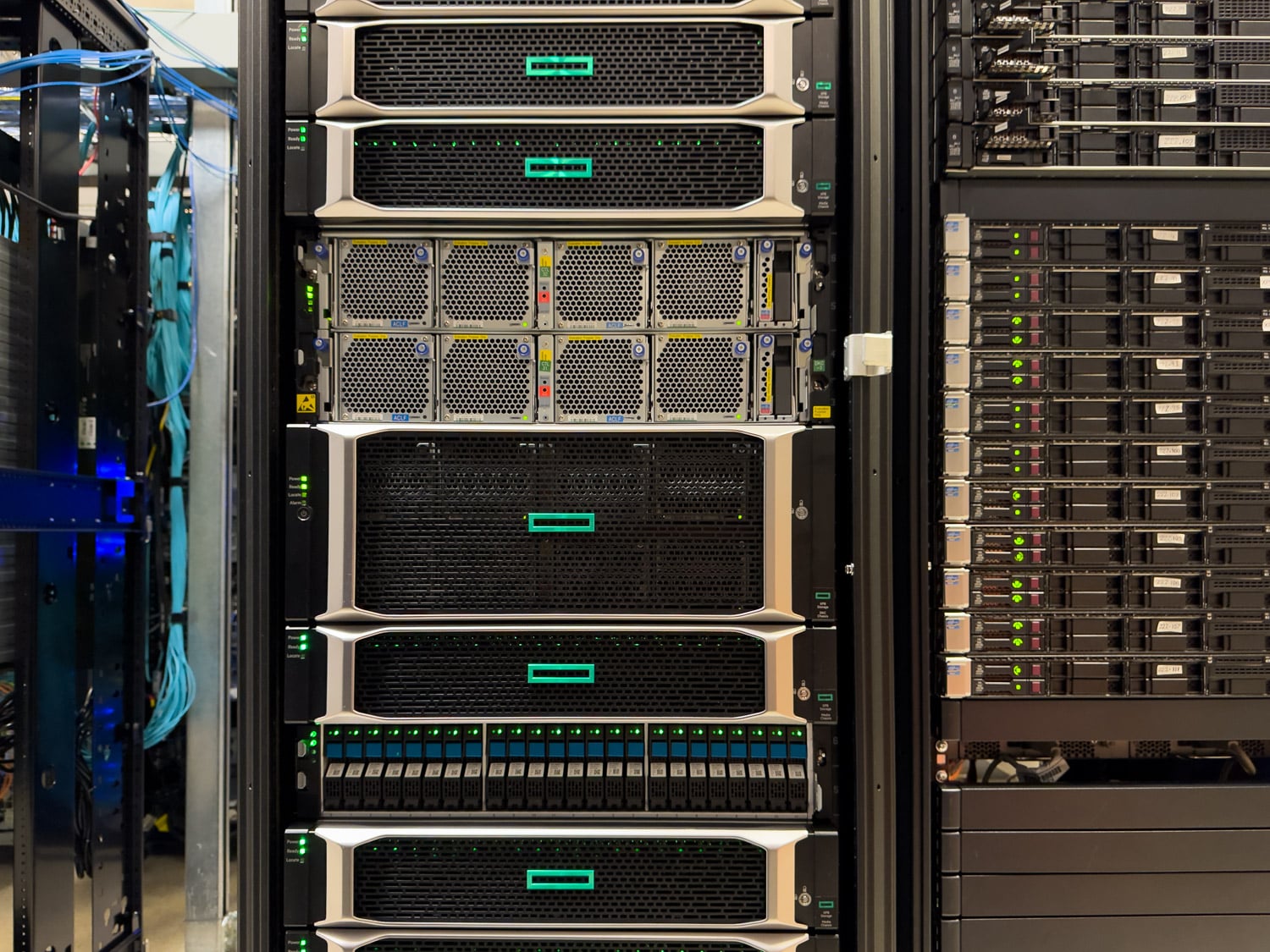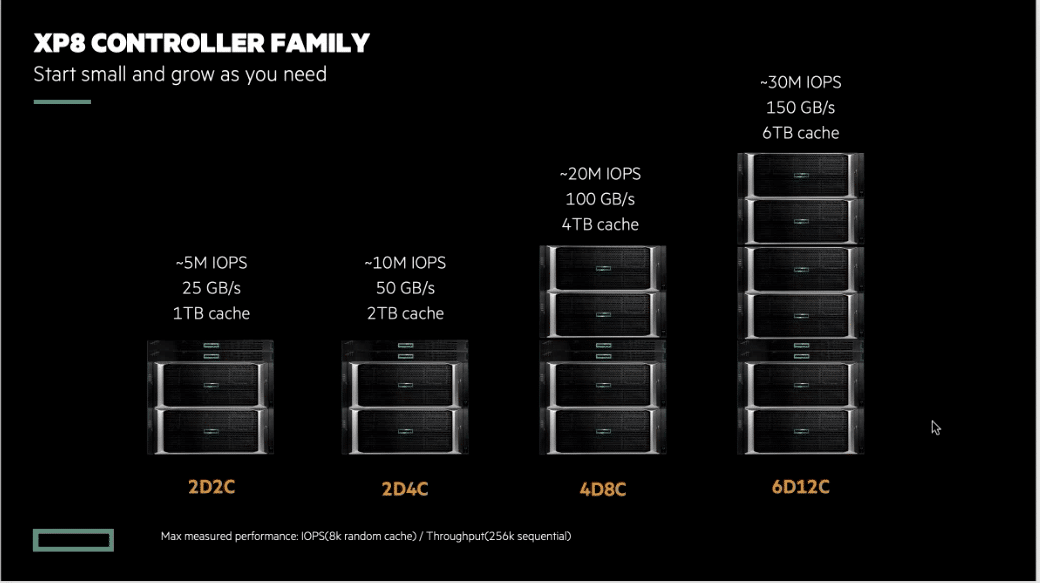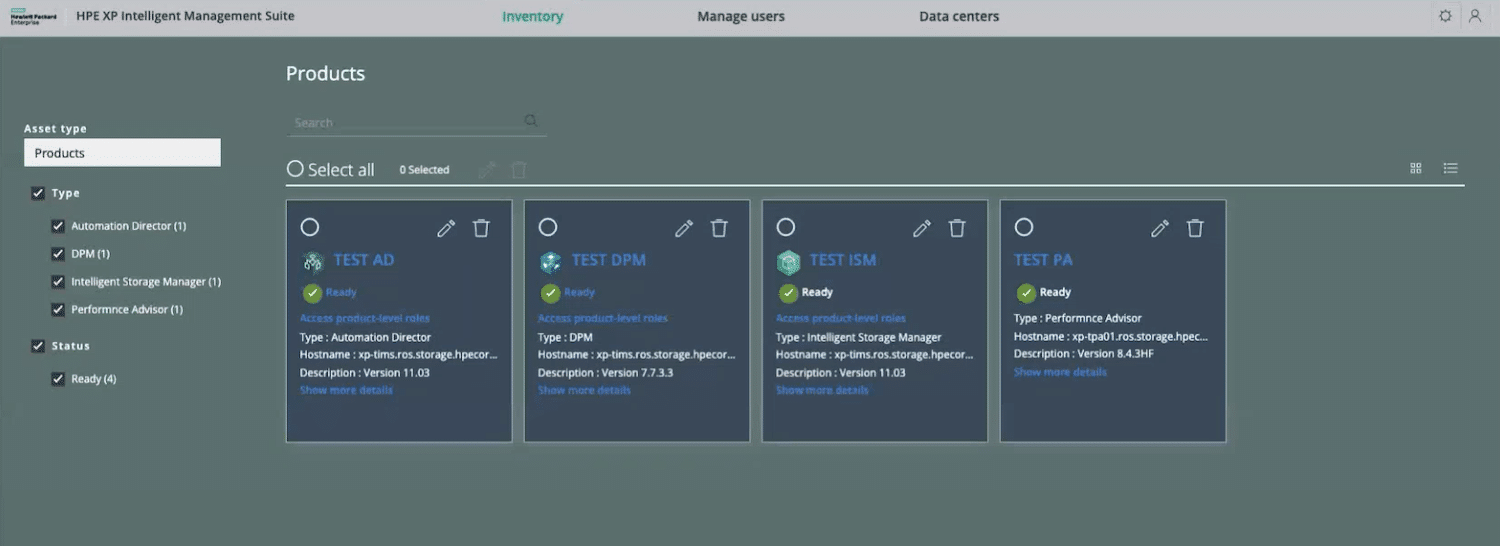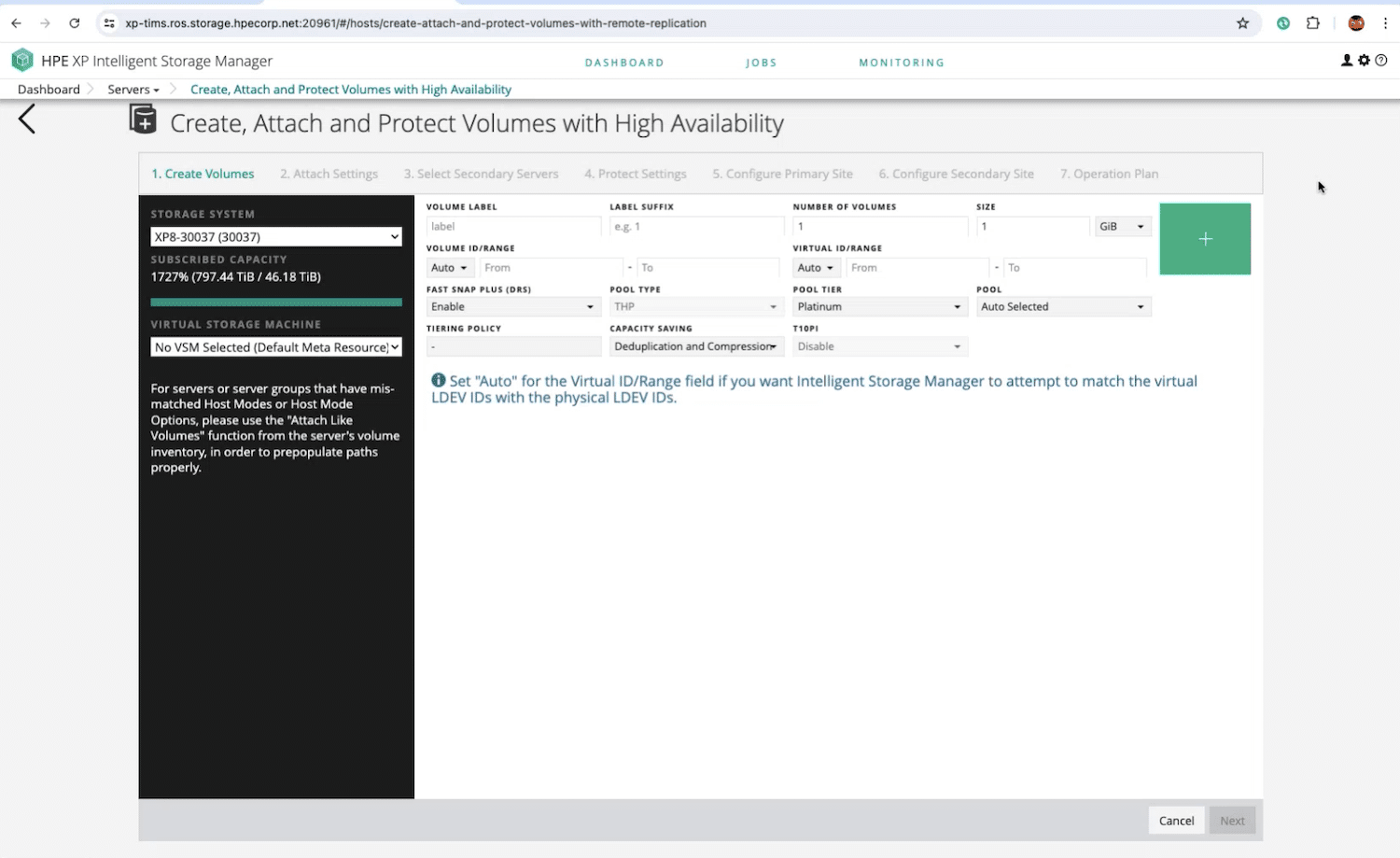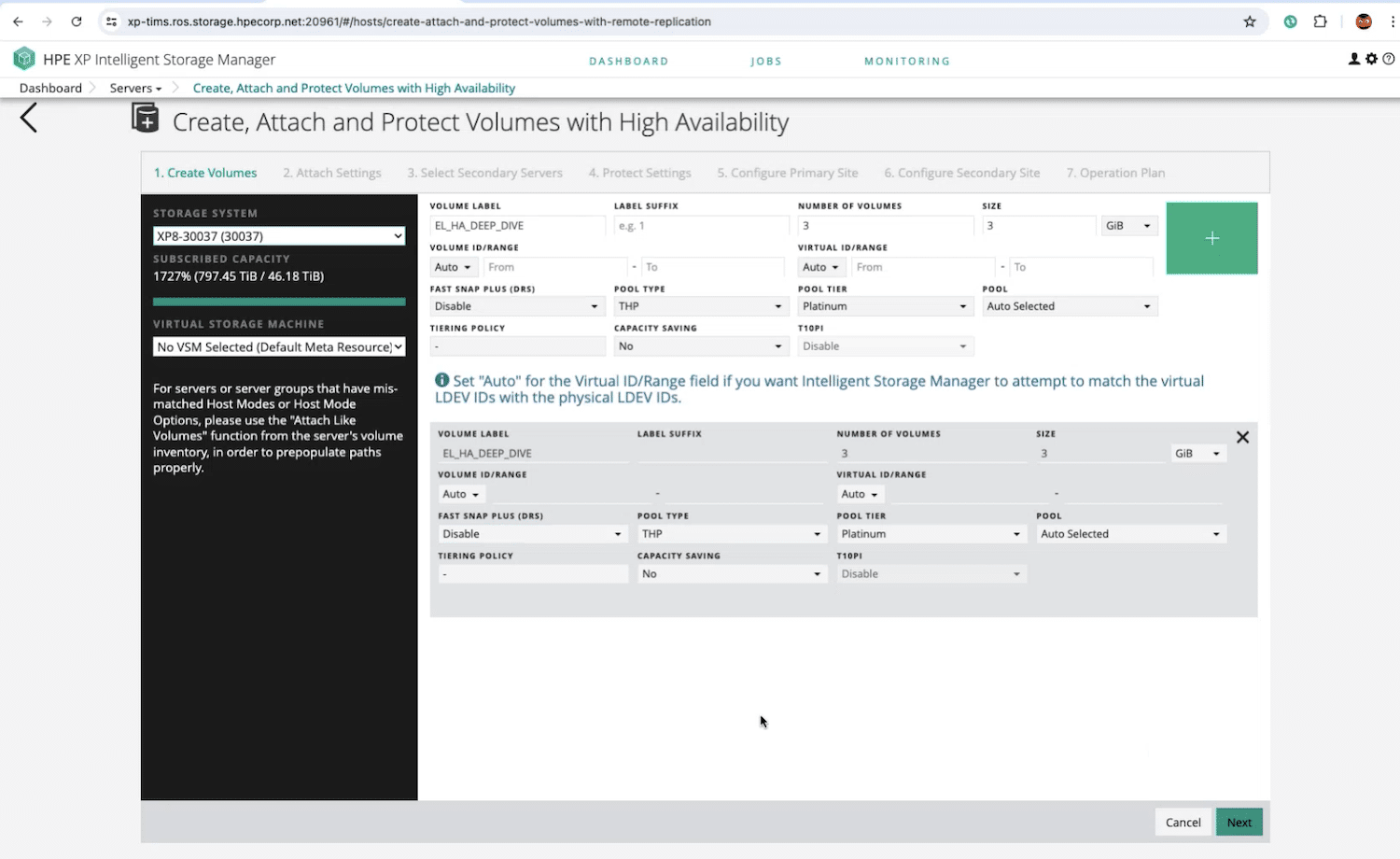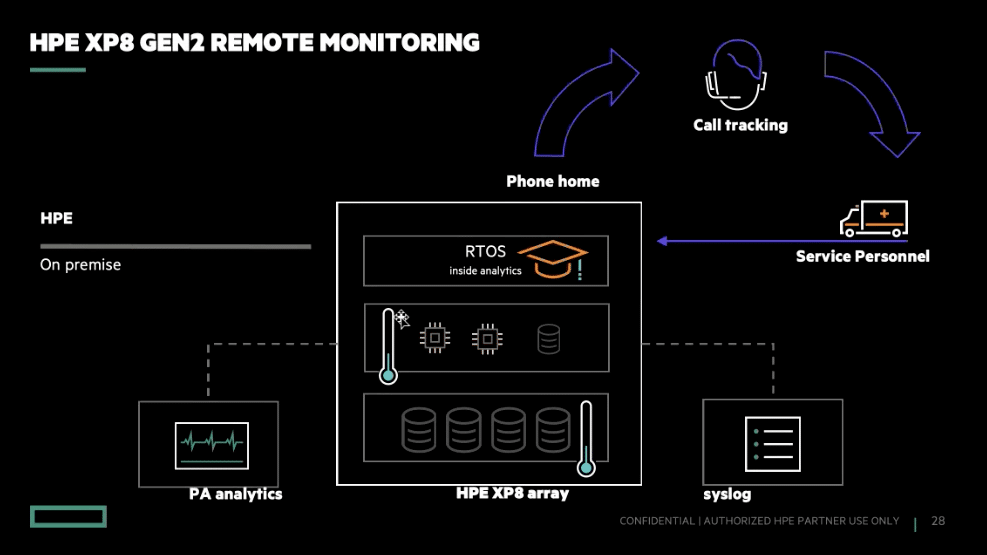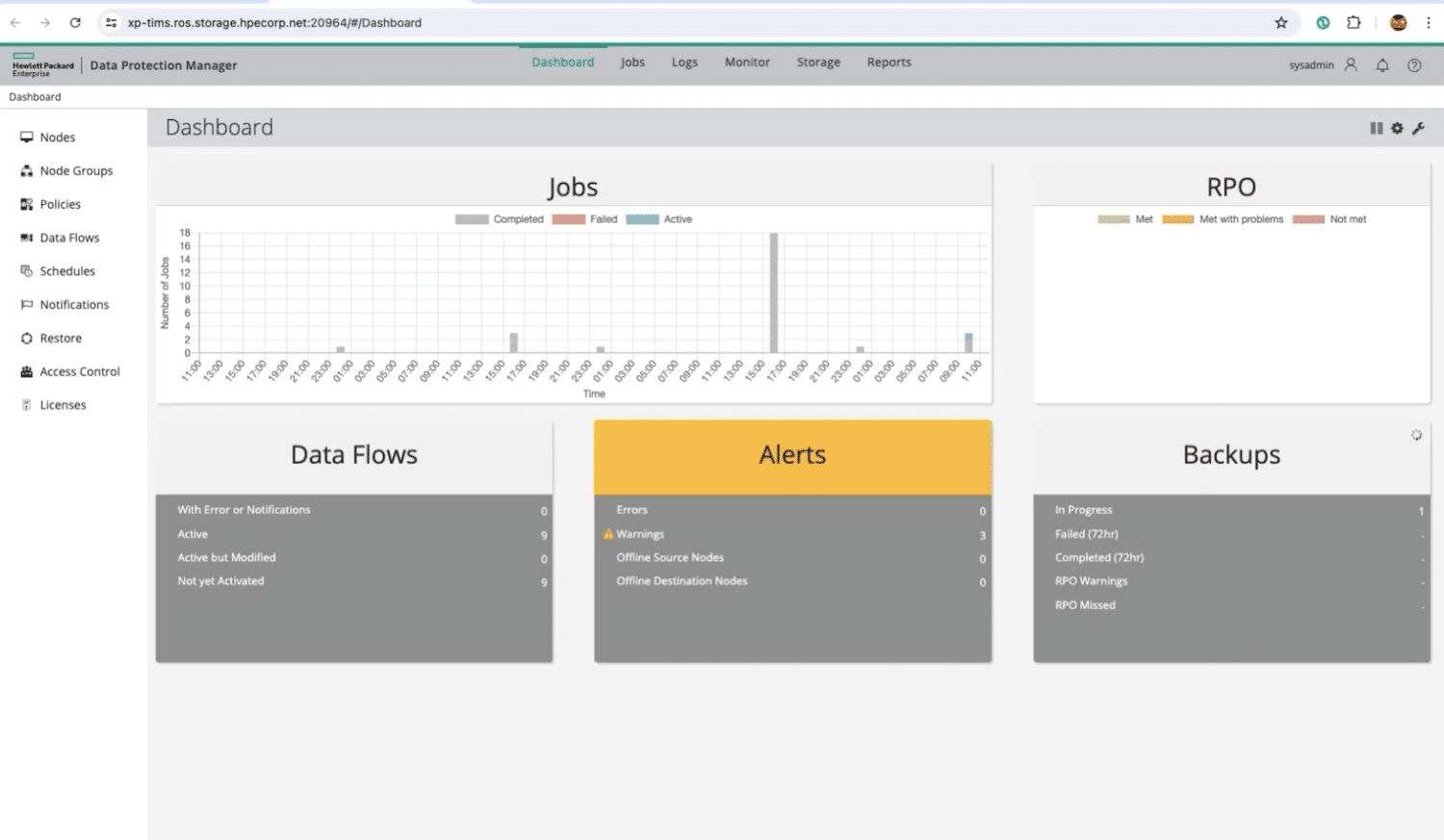HPE XP8 storage is a comprehensive, reliable, and scalable solution for enterprises that demand the highest performance and availability.
Few devices can boast 100% data availability over ten years, and achieving that milestone would seem almost unattainable. However, the HPE XP storage arrays have raised the reliability bar, surpassing the industry standard five nines and delivering zero downtime for mission-critical applications.
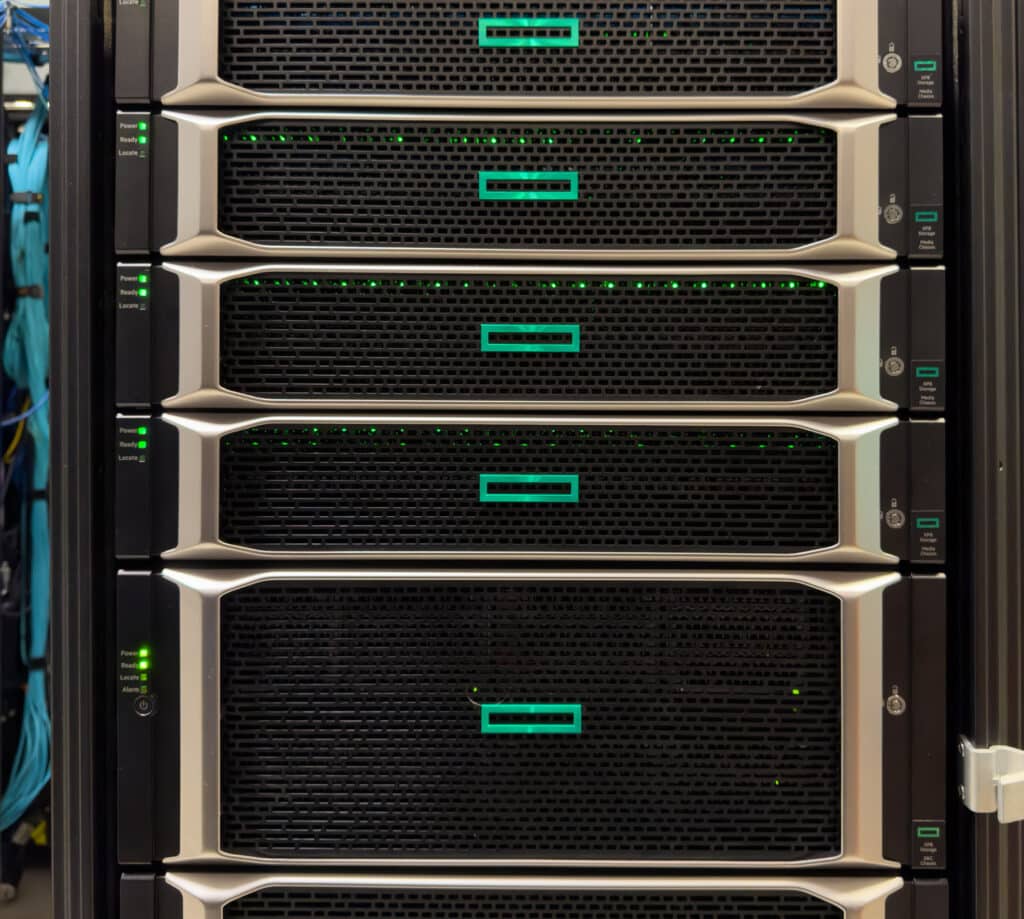
This milestone can be attributed to the robust engineering of the XP7 and XP8 models, which offer seven-nines and eight-nines reliability, respectively. Additionally, HPE’s validation and testing processes ensure even greater reliability. In fact, the XP8 Gen2 pushes performance even further with up to 33 million IOPS with less than 40ms latency, driving this array to the highest availability in the industry.
XP8 Hardware Architecture Overview
The HPE XP8 storage array is built on a hardware architecture that delivers enterprise-grade performance, scalability, and resilience. Part of the XP8’s magic is its highly modular design, which allows it to be tailored to various business needs, from small-scale deployments to massive, mission-critical environments. The XP8’s architecture is centered around the Disk Controller (DKC) and Controller Chassis, which work in tandem to manage data flows, redundancy, and storage efficiency.
The XP8 storage array architecture ensures reliability through full online scalability and redundant hardware. Advanced features like data replication, disaster recovery, and online data migration ensure high performance. In addition, compression and deduplication features further enhance resource utilization, driving efficiency and cost-effective storage management.
XP8 storage virtualization integrates seamlessly with clustering solutions, providing comprehensive business continuity, disaster tolerance, and data protection. This virtualization also increases availability, simplifies disaster recovery, and reduces storage silos, further improving resource utilization. The XP8 Flash Module Devices (FMD) cater to extreme performance needs with low latency. Flash memory drives significantly improve data storage performance while simultaneously lowering costs, making them an efficient solution for solid-state non-volatile data storage needs.
XP8 Modular Design
HPE’s design philosophy allows components to be added or upgraded as needed without disrupting operations, making the XP8 a highly adaptable solution for growing businesses. The modularity extends across the entire system, including the storage controllers, disk enclosures, and connectivity options.
The XP8 architecture makes it easy to scale from an entry-level two DKC/2 controller configuration to a robust six DKC/12 controller system. Internal storage can scale up to 69PB, and virtualized external storage can scale up to 255PB. The XP8 supports various storage options, including NVMe and SAS SSDs, Storage Class Memory (SCM), Flash Module Devices (FMD), and HDDs. This versatility enables deployments tailored to specific application workloads.
Starting with a two-controller DKC, the system can be upgraded to improve performance and capacity. Components can be scaled independently, providing granular control over the system’s capacity and performance. The ability to swap out components without downtime also ensures that the XP8 can grow as business needs evolve. The XP8’s front end also supports FC-NVMe, providing faster host connectivity and improved CPU efficiency. Its virtual storage layer ensures uninterrupted data access during server or OS maintenance, allowing one side of an application cluster to be taken offline while maintaining data availability through the other side.
| Technical specifications HPE XP8 Storage | |
|---|---|
| Drive description | SAS SFF SSD and HDD, LFF HDD, SCM (Storage Class Memory), FMD (Flash Module Device) and NVMe SFF |
| Capacity | 69 PB Raw ~60 PB Usable 255 PB External Storage |
| Host interface | 16 Gb FICON SW FC (192 Ports) 16 Gb FICON LW FC (192 Ports) 32 Gb FICON SW FC (192 Ports) EDiF-ready 32 Gb FICON LW FC (192 Ports) EDiF-ready 16/32 Gb FC HBA (192 Ports) 10 G iSCSI (96 Ports) |
| Cache | 6 TB maximum supported cache capacity 32 GiB or 64 GiB memory sizes Encrypted or non-encrypted cache back-up modules |
| Availability features | All active components are redundant and hot-swappable. Online scalable fully redundant hardware platform with unique High Availability SW solutions for complete business continuity and data protection. Supports multiple RAID levels for data protection. |
| Compatible operating systems | HPE NonStop VMware® HP-UX IBM AIX Linux® Mainframe Microsoft® Windows® Oracle Solaris |
| Product dimensions (imperial) | HPE XP8 Performance Disk Controller Chassis 19 x 30 x 17.1 in (W/D/H) |
| Weight | 326.5 lb. HPE XP8 Performance Disk Controller Chassis Pair (includes chassis, controllers, PCB, no drives or adapters) |
| Warranty | Warranty level of hardware reactive support is three years, 24×7, with a 4-hour onsite response. |
Resiliency: Layers of Redundancy, Failover Mechanisms
The HPE XP8 Storage Array is engineered to deliver unprecedented resiliency, ensuring continuous availability and data integrity for mission-critical workloads. The XP8 provides multiple layers of redundancy and failover mechanisms designed to prevent downtime and data loss, even during hardware failures or other disruptions.
A critical feature of the HPE XP8 Storage Array is its active-active architecture, which enables seamless failover between storage controllers. In the event of a controller failure, the remaining controller(s) automatically take over the workload without disrupting applications or users. The architecture includes redundant power supplies, cooling systems, and data paths. These redundancies are designed to eliminate single points of failure, enhancing the system’s reliability. Should a hardware failure occur, the XP8 automatically triggers failover processes to maintain data availability. This level of resilience is critical for enterprises that cannot afford downtime, ensuring that data remains accessible even in the face of hardware malfunctions.
In addition to hardware redundancies, the HPE XP8 employs advanced data protection features such as RAID to safeguard against disk failures. The array supports various RAID levels, allowing organizations to choose the level of protection that best meets their needs. Furthermore, the XP8 offers Continuous Access (CA), a replication technology that provides synchronous and asynchronous replication to a secondary site. This ensures data is always protected and quickly recovered following a disaster.
The HPE XP8 Storage Array also includes automated failover mechanisms for remote replication. If the primary site becomes unavailable, the array can automatically failover to a secondary site, ensuring that business operations continue without interruption. This capability is critical for organizations that require high availability and disaster recovery solutions.
Overall, the HPE XP8 Storage array is designed with resilience at its core. It offers a combination of hardware redundancies, advanced data protection, and automated failover mechanisms to ensure that critical data and applications remain available at all times.
Performance Advisor
HPE XP8 Performance Advisor Software is a sophisticated, web-based application designed to collect, monitor, and display HPE XP8 Storage system metrics.
Performance Advisor offers an end-to-end view from a single VM to a single LUN. The improved alerting mechanism has a finer, customizable granularity for all hardware monitoring. Through real-time hardware monitoring and analytics, performance issues can be correlated to hardware failure.
One feature of Performance Advisor is Fine Grain SAN. This tool can diagnose and measure internal and external I0 latencies—internal to the XP array and external in the SAN.
Significantly, this software lets users precisely choose the time and duration for performance data collection to target specific activities impacting the performance of the HPE XP8 array. The Performance Advisor provides information for administrators to fine-tune the storage array to deliver optimized performance.
HPE XP8 Performance Advisor monitors storage performance and presents administrators with usage statistics at various levels, ranging from a comprehensive system overview to detailed insights into individual components. The software also offers filtering capabilities focused on the most relevant hosts, arrays, and array components. Additionally, users can generate, schedule, and review detailed performance reports, which help identify and address any performance bottlenecks within the HPE XP8 Storage system.
VM Analytics is a powerful feature for analyzing VMWare virtual environments and storage arrays. VM latency can be easily correlated with activity on the host, on any datastores used by the VM, and at the level of the individual VMDK. The graph shows neighboring VMs that share a datastore with the VM under examination and thumbnail graphs of all their IOPS, throughput, and latency.
HPE XP8 Performance Advisor also integrates with HPE XP8 Tiered Storage Manager, providing valuable Array Group performance data. This integration allows Tiered Storage Manager to monitor access patterns and consider performance implications before migrating data, enhancing overall storage management.
It is important to note that HPE XP8 Performance Advisor Software is not supported in mainframe environments.
Real-Time OS (RTOS)
The Real-Time OS (RTOS) (part of the HPE XP8 array) takes thousands of measurements and analytics to monitor the array’s health and interact with the HPE remote monitoring dial home functionality. The system logs all triggered thresholds—this data can be sent to a syslog server (for example) or monitored and logged by Performance Advisor.
HPE XP8 includes Remote Monitoring. As previously mentioned, the system is constantly monitored, and, using the data collected via RTOS analytics, if an anomaly begins within the array, the system will write an entry to syslog, add an entry to Performance Advisor, and, if the event is severe enough based on the analytics, initiate a “phone home” instance. The phone home mechanism creates a ticket to dispatch HPE service engineers to the site.
Controller and Disk Controller Customization
The XP8’s controller configuration is another vital aspect of its architecture. The HPE XP8 DKC is critical to the system’s architecture. Two XP8 models are available to meet different performance and availability requirements. Each DKC model is always deployed in pairs to ensure redundancy and fault tolerance, a key feature in maintaining the promise of zero downtime.
The Base DKC pair is the entry-level configuration, equipped with one controller board in each controller chassis. This setup is ideal for customers prioritizing high availability but not requiring extreme performance levels. The Base DKC is well-suited for environments where IOPS (Input/Output Operations Per Second) demands are moderate, but continuous data access and system uptime are non-negotiable.
The Performance DKC pair is the advanced option for customers with higher performance requirements, featuring two controller boards in each controller chassis. This configuration significantly boosts the system’s IOPS capacity, making it ideal for demanding workloads that require rapid data processing and low latency. The increased number of controllers improves the system’s ability to manage larger volumes of concurrent data access requests, making it a preferred choice for high-transaction environments, such as financial services or large-scale databases.
One key advantage of the XP8 architecture is its flexibility. Customers who initially deploy the Base DKC can upgrade to the Performance DKC as their needs evolve, ensuring that the storage infrastructure can scale in line with business growth. This upgrade path protects the initial investment while providing a clear path for performance enhancements.
The XP8 controller chassis system provides scalable options to satisfy moderate and high-performance demands. It focuses on maintaining continuous availability and ensuring that storage performance grows with the organization’s needs. Each controller within the DKC is responsible for managing data access, I/O operations, and maintaining data integrity. These controllers work in an active-active configuration, meaning that if one controller fails, the other seamlessly takes over, ensuring uninterrupted service.
Customers with third-party legacy storage can virtualize and connect those arrays to the XP8. This is an opportunity to add up to 250PB behind the XP8. However, performance for those third-party arrays is not managed through Performance Advisor, so customers must deal with performance issues separately.
Scalability (Up and Down)
Unsurprisingly, the HPE XP8 is designed with scalability in mind, supporting both vertical and horizontal scaling. Vertical scaling lets businesses increase the capacity of existing components, like adding more drives to existing enclosures. Horizontal scaling involves adding additional controller chassis units and storage enclosures, effectively expanding the system’s overall capacity and performance capabilities. As noted above, the XP8 supports various drive types, including SSDs and high-capacity HDDs, enabling organizations to customize their storage configurations to match their specific needs. Whether you need to scale up for more capacity or scale down to optimize costs, the XP8 provides the flexibility to do so.
Not To Be Overlooked
Beyond its core architecture, the XP8 includes several other hardware design elements that set it apart. For instance, the XP8 has advanced cooling technologies that optimize airflow and reduce power consumption. This not only improves the system’s energy efficiency but also extends the lifespan of the hardware components. The XP8 also includes hot-swappable components, allowing easy maintenance and upgrades without powering down the system. This feature is particularly beneficial for organizations that demand constant uptime.
Validation is Key
HPE takes several additional steps to ensure the XP8 delivers continuous availability. One key initiative is extensive validation testing. HPE rigorously tests each component of the XP8 to ensure that it meets the highest standards for reliability and performance. This validation process includes stress testing under various load conditions to simulate real-world usage scenarios.
HPE also offers proactive support capabilities, leveraging AI-driven analytics to predict potential issues before they affect the system. This proactive approach allows for preemptive maintenance, further reducing the risk of downtime. Additionally, HPE’s Remote Copy software provides data replication between XP8 arrays, ensuring data redundancy across geographically dispersed locations.
Compression Accelerator: Impact on Capacity and Performance
The XP8 Compression Accelerator is a specialized hardware component that enhances storage efficiency and performance. Data is compressed in real-time as it is written to the storage media, effectively increasing the usable capacity of the storage array.
Unlike software-based compression, which can introduce latency, the hardware-based Compression Accelerator in the XP8 operates at line speed, ensuring that IOPS and latency metrics remain unaffected. This is particularly beneficial for environments with large volumes of data, such as databases and virtualized workloads, where maximizing storage efficiency is crucial.
The HPE XP8 provides DKC (controller-based) data compression and deduplication for its SAS SSDs, HDDs, and NVMe drives. When combined with thin provisioning, snapshots, and data pattern matching, users can achieve up to 8:1 gains in storage capacity savings.
The algorithms for compression and deduplication are optimized for RAID 6, providing efficient results with minimal impact on workloads. Increasing the deduplication stores to 24 and the volume stores to 24 storage devices per pool enhances IO multiplicity when deduplication is enabled. The smaller access size for data reduction metadata helps reduce overhead.
Performance
Regarding performance, the XP8 delivers high IOPS and low latency, making it ideal for demanding enterprise workloads. HPE’s internal testing has demonstrated that the XP8 can handle millions of IOPS while maintaining sub-millisecond latency, even under heavy load conditions. These performance metrics are critical for applications that require real-time data access, such as online transaction processing (OLTP) systems and large-scale virtualization environments. The XP8’s architecture, including its use of NVMe SSDs and advanced caching algorithms, plays a significant role in achieving these performance figures.
Software Benefits
Intelligent Management Suite
The HPE XP8 is delivered with all-inclusive software that proactively monitors, detects, and resolves issues before they impact system availability or performance. This is made possible by integrating advanced AI capabilities, such as Performance Advisor, VM analytics, and Continuous Track data analytics. These tools provide real-time insights into the system’s operations, identifying potential bottlenecks and inefficiencies long before they manifest as problems. Future support for HPE InfoSight, a leading AI-driven management platform, will further enhance these capabilities, offering predictive analytics and automated troubleshooting that continuously learn from the global installed base of HPE storage systems.
HPE continues to simplify its management tools by integrating existing software, like Data Protection Manager, for a consistent user experience. The Intelligent Management Suite toolbox includes features critical to achieving the resiliency the XP8 enjoys. The dashboard provides a single frame where users can select from Automation Director, Data Protection, Intelligent Storage Manager, and Performance Advisor.
Menu Driven, Confident Deployment
An easy-to-follow series of configuration screens provides everything from selecting servers to creating volumes, attaching storage, adding protection, and making it operational. This comprehensive management tool chest makes errors almost impossible to make.
Streamlining Storage Provisioning
Another critical component of the HPE XP8 is the Intelligent Storage Manager. This software provides a unified interface that allows administrators to view the status of all resources at a glance. It streamlines the deployment, management, and maintenance of HPE XP storage, reducing the complexity traditionally associated with enterprise storage management. The Intelligent Storage Manager is designed to handle everything from initial setup to ongoing optimization, ensuring that storage operations are as efficient and effective as possible.
Storage Provisioning is particularly beneficial in dynamic environments where storage needs change rapidly. Administrators can provision new volumes, adjust existing allocations, and manage storage tiers with just a few clicks without downtime. This ease of use reduces the time spent on routine tasks and minimizes the risk of configuration errors.
High-Availability Made Easy
HPE has removed the complexity of configuring high availability. The step-by-step approach using the Intelligent Management Suite makes it almost effortless. Should a configuration mismatch occur, the system notifies the admin before proceeding to the next step.
Proactive Support Capabilities
The XP8 integrates proactive support capabilities that leverage AI and machine learning to predict potential issues before they occur. This proactive approach to support allows for preemptive maintenance and reduces the likelihood of unplanned downtime. The system continuously monitors itself, analyzing performance data and environmental factors to detect anomalies. The system can automatically notify administrators or trigger corrective actions when potential issues are identified.
Data Protection
The HPE XP8 Data Protection Manager provides a modern data protection and copy management approach designed to enhance data availability, ensure compliance, and improve operational agility. This tool uses built-in intelligence to guide users through creating policies and workflows, automating replication, and copying data management processes. By simplifying these tasks, the Data Protection Manager protects data with minimal manual intervention, ensuring that data is always available and compliant with regulatory requirements.
Integration for Enterprise Environments
The XP8 is designed to integrate seamlessly into existing enterprise environments, supporting a wide range of operating systems, hypervisors, and applications. This level of integration simplifies deployment and management, allowing the XP8 to fit into diverse IT ecosystems with minimal disruption. Additionally, the XP8 supports storage virtualization, enabling it to front-end other arrays for seamless data migration and consolidation. This feature is helpful for organizations looking to modernize their storage infrastructure without undergoing a complete overhaul.
Storage Virtualization Engine
The XP8’s storage virtualization engine is a powerful tool for enterprises undergoing digital transformation. This engine allows the XP8 to act as a front-end for legacy storage arrays, enabling seamless data migration without downtime. This capability is crucial for businesses that need to modernize their storage infrastructure while maintaining access to critical data. By virtualizing the storage environment, the XP8 simplifies data management and reduces the complexity associated with large-scale migrations.
Supported Features and Systems
| Feature | Supported Systems | Description |
|---|---|---|
| Open Volume Manager | Open Systems | Create expanded volumes that are larger than standard volumes (also called LU Size Expansion or LUSE) and custom-size volumes that are smaller than standard volumes (also called Custom Volume Size or CVS). |
| Virtual LVI (VLVI) | Mainframe | Create custom-sized mainframe volumes smaller than standard volumes (aka Custom Volume Size or CVS). |
| Data Retention Utility | Open Systems | LUN access control enables archiving and data retention. It protects key files from being updated, copied, accessed, or queried. It is also known as the LUN Security XP Extension. |
| Cache Residency Manager | Mainframe | Improve performance by reserving areas of Cache Memory for frequently accessed data. |
| Volume Retention Manager | Mainframe | Volume access control enables archiving and data retention. Assign access permissions (read/write, read-only, and protect) to mainframe volumes. |
| Performance Control | Open Systems | Allocate disk array port I/Os and transfer rate so that your most important applications have the needed performance. This is also known as Server Priority Manager. |
| Performance Monitor | Both | Monitor usage, workload, and performance of drives, volumes, processors, and host interfaces in the HPE XP7 Storage. View the information in graphical formats. |
| Volume Shredder | Both | Securely delete data with repetitive overwrites to minimize the likelihood that it could be recovered. Overwrite up to eight times with random or user-selected patterns. Also referred to as Data Shredder. |
| RAID Manager | Both | The host-based command line interface controls HPE XP7 continuous access, HPE XP7 business copy, and data retention utility (LUN Security XP Extension). |
| Cache Partition | Both | Reserving areas of cache to store frequently accessed data can improve performance. Performance can also be enhanced by dividing the cache into up to 32 partitions and configuring a dedicated cache for critical applications. |
| MF Performance Collector | Mainframe | Improves the time and precision in analyzing mainframe performance data from host and storage. |
| Advanced QoS | Both | Set volume and volume group level upper limits for IOPs and MB/s. |
| Policy-based Media Sanitization | Both | Set media sanitization policies to erase retired media, eliminating the need to send media back to the vendor or hire a 3rd party. |
HPE GreenLake
HPE’s GreenLake model offers a flexible, consumption-based approach to IT infrastructure, and the XP8 is a natural fit within this framework. By deploying the XP8 as part of a GreenLake solution, organizations can leverage the benefits of the XP8’s performance and reliability while aligning costs with usage. This as-a-service model simplifies budgeting and allows for easier scaling as storage needs evolve.
According to Rupin Mohan, General Manager, P&L Owner, Strategy, Product Development, and CTO, customers are buying HPE XP as a classic GreenLake solution, where HPE comes in and takes care of all the infrastructure for that customer. Mohan noted that HPE works with the customer and takes [them] through the whole lifecycle of compute, storage, and networking.
Conclusion
The HPE XP8 storage array stands out as a comprehensive, reliable, and scalable solution for enterprises that demand the highest levels of performance and availability. Its modular design, architectural redundancy, and advanced software capabilities make it an ideal choice for mission-critical environments. Investing in the XP8 ensures organizations are prepared to handle the growing demands of data-intensive applications.
Overall, the HPE XP8 storage system combines advanced AI-driven intelligence, comprehensive management tools, and user-friendly interfaces to deliver a powerful, flexible, and easy-to-manage storage solution that meets the demands of modern enterprise environments.
As data volume and complexity increase, the XP8 enables organizations to manage and protect their information assets. The HPE XP8’s hardware architecture, intelligent software suite, and proactive support capabilities position it to meet the challenges of the modern data landscape and beyond.
This report is sponsored by HPE. All views and opinions expressed in this report are based on our unbiased view of the product(s) under consideration.
Engage with StorageReview
Newsletter | YouTube | Podcast iTunes/Spotify | Instagram | Twitter | TikTok | RSS Feed


